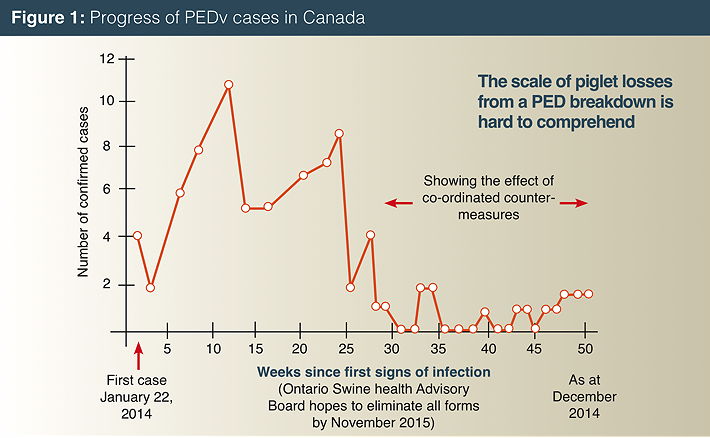PED is by far the most serious recent disease to hit pigs in terms of profit loss, and much has been written about it. This article is rather different as it deals with the experiences of several large and efficient North American pig breeding farms that were badly hit by the PED virus last year, and which are now reasonably back to normal productivity.
Several were my clients in the past, and I have visited them so I know their farms and their capabilities as knowledgeable pig farmers, and can trust their advice. I also asked them if their vet approved of what actions they took – just to be certain of their validity.
As TGE (transmissible gastroenteritis) is similar to PEDv, I contacted them for two main reasons. First, the apparent similarity in symptoms and their effect raised my interest considerably, as 40 years ago on the 1,200-sow Taymix farm where I was employed as technical director, we were suddenly hit by TGE and lost nearly every piglet born for three solid weeks. Back then, the owner flew me to Minnesota, where the focus of the American outbreak was, to try to find out from their veterinary epidemiologists what to do to curtail these disastrous losses, which if they continued for much longer, severely threatened future cashflow and could finish the business. It now seemed that what to do to combat and recover from PEDv could be very similar to what we were told to do for TGE all those years ago.
Second, during the past year my telephone and email correspondence with those hard-hit reveals that should any pig industry be unfortunate enough to contract the really virulent strain of PEDv, then the advice from Canada and America has been emphatic – even to the point of dogma. One farmer – one of the best-known pig managers in America – said to me “Now listen up, should it hit you, this is what you have just gotta do!”
Nevertheless, what they were all saying tended to conflict in places with what my training and experience in dealing with any disease from a management point of view built from visiting hundreds of pig units across 40 years or more. What the Canadian and American contacts of mine were advising in the vital area of overcoming the trauma as quickly as possible (as we needed so urgently to do at the Taymix farm all those years ago) made me nervous, but as the following remarks suggest, there could be solutions.
So, what follows is what I was told, with each piece of advice followed by my views on it.
PED is super infectious
The PED virus is highly virulent. Just 2ml of inoculum could infect every pig in Europe. PED took only a year to infect half of the huge and widespread US herd.
> This is hardly surprising as footwear, clothes and vehicles (pig transport trucks were critical viral transmitters), as well as birds, are all primary vectors, and staff at all levels, at farms and their suppliers, must be made acutely aware of this. Should the virus arrive locally, extreme attention to farm biosecurity is essential, even to the point of refusing any visitors whatsoever/visiting other farms, and the producer and his workers not attending farmer meetings, livestock shows or markets. Even shoes leaving an infected farm are probably carriers – this particular virus being so infective that it’s quickly picked up on other shoes treading the same space, so virulent are microscopic amounts of the virus.
Co-ordination speeds recovery
It’s the length of recovery from having no finished pigs to sell for weeks at a time that’s so threatening to survival. Each nation should have in place a regional surveillance and control plan co-ordinated from a national control centre. This was, once established, a major factor in containing and eliminating the US outbreak as quickly as possible.
> AHDB Pork has already published some 14 standard operating procedures (SOPs) online. Most of them are very comprehensive and clear about what to do in the four main areas of control: protecting against the disease; eliminating it quickly; preventing the virus from leaving an infected farm; and lessening the chance of reinfection, which with this especially virulent virus is always possible, especially in warmer summer weather.
The SOPs are online, and if you haven’t already looked them up, then you should. There are some hard disciplines there, especially in assisting speedy recovery from the disease. “That’s the killer,” I was told, “income drying up from no finished pigs shipped for weeks on end.” The Canadians in particular (compared to the Americans) seem to have got on top of the scourge with commendable speed as Figure 1 shows. And they feel that their PEDv Advisory Board and its Rapid Response Team have been a major reason for this.
Limewashing is a useful control
All American producers reported the success of limewashing surfaces and using industrial space heaters to dry them thoroughly overnight at 40C; this was in preference to the standard detergent/approved disinfectant sanitation routine.
> As far as I’m concerned, limewash seals in the virus but has a poor virus kill response. I asked every farmer I contacted whether their vet approved of this old-fashioned method. It seems most vets were hesitant, with which caution I totally agree. Limewash should only be used where the walls/pen divisions are made from unrendered concrete blocks, as limewash seals the crevices excellently. Otherwise, use the approved products on sale.
Virus feedback
All farmers favoured and strongly advised feedback to all sows for three weeks as soon as an outbreak was diagnosed. Either the gut contents of some infected neonates, or their minced-up intestines and digesta. This works best, I was told, if the inoculum was taken from piglets noticed as being colostrum-deprived.
> To be frank, this practice has always worried me, and now I never advise it as it can spread other diseases too. I’ve seen bad cases of E coli scours and swine dysentery occur soon after feedbacking, and more serious, prolonged cases of infertility. However, many Canadian and US farmers were so adamant about the success of feedbacking in getting through PEDv quickly, that they’ve made me think. So what’s the answer?
My viewpoint now is that digesta feedback (never faecal) can be considered for this disease, but without exception it must be authorised by a responsible vet who, after tests, knows the farm and the history of its disease profile. Even more importantly, the method must be designed and carried out under his instruction only, and not what the farmer or his staff thinks has worked in the past or what other producers recommend. The immune status of your pigs is different to anyone else’s, and the method of feedback that has worked for them could still damage your stock.
Weaning advised at seven days
The North American producers were convinced that getting any piglets that survived and were not visibly ill by seven days of age off the farm would speed up recovery from the disease in the whole herd. Otherwise, euthanise the moribunds. “They won’t make it, and only slow-up recovery,” was the most common comment.
> Again that may well be of benefit, but I’d suggest seeking an opinion from a vet who knows the farm. Mass euthanasia on a sizeable unit can be brutal for the piglets and demoralising for the staff. Getting them off the farm as soon as possible is all very well if you have somewhere else to put them. Emergency off-farm accommodation fixed up with a poultry or beef neighbour is worth thinking about in advance. Keep your and your neighbour’s vet in the loop.
Cross-fostering slows progress
Some producers said cross-fostering delayed recovery and elimination of PED from the herd.
> This is a difficult one for me to judge as the Americans seem less skilled at the different variants of piglet swapping than we are in North-west Europe. Maybe those who thought it delayed recovery weren’t doing it skilfully enough and were holding back the pigs?
The North American experience, especially in the US, was that pigs got very short, the price shot up, and while this lasted some of the lost income was recovered. But it was still a shattering experience for producers involved, just as it was with TGE at Taymix all those years ago.
The SOPs produced by the AHDB are currently our best line of defence. They can be found HERE





